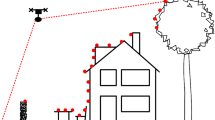Abstract
A vision-based terrain referenced navigation (TRN) system is addressed for autonomous navigation of unmanned aerial vehicles (UAVs). A typical TRN algorithm blends inertial navigation data with measured terrain information to estimate vehicle’s position. In this paper, however, we replace the low-cost inertial navigation system (INS) with a monocular vision system. The homography decomposition algorithm is utilized to estimates the relative translational motion using features on the ground with simple assumptions. A numerical integration point-mass filter based on Bayesian estimation is employed to combine the translation information obtained from the vision system with the measured terrain height. Numerical simulations are constructed to evaluate the performance of the proposed method. The results show that the precise autonomous navigation of unmanned aircrafts is achieved by the vision-based TRN algorithm.
Similar content being viewed by others
Explore related subjects
Discover the latest articles, news and stories from top researchers in related subjects.References
Bergman, N.: Recursive Bayesian estimation: navigation and tracking applications. Ph.D. Dissertation, Linköping University, Linköping, Sweden (1999)
Hostetler, L., Andreas, R.: Nonlinear Kalman filtering techniques for terrain-aided navigation. IEEE Trans. Automat. Contr. 28(3), 315–323 (1983)
Oliveira, P.: MMAE terrain reference navigation for underwater vehicles using eigen analysis. In: Proc. of the 44th IEEE CDC/ECC 2005, Seville, Spain (2005)
Nonsen, K.B., Hallingstad, O.: Sigma point Kalman filter for underwater terrain-based navigation. In: Proc. Of IFAC Conference of Control Appli. Marine Syst. (2007)
Nonsen, K.B., Hallingstad, O.: Terrain aided underwater navigation using point mass and particle filters. In: Proc. of IEEE/ION Position Location Navigat. Symp., pp. 1027–1035 (2006)
Agrawal, M., Konolige, K.: Real-time localization in outdoor environments using stereo vision and inexpensive gps. In: Proc. of the 18th International Conference on Pattern Recognition, pp. 1063–1068 (2006)
Kaiser, K., Gans, N., Dixon, W.: Localization and control an aerial vehicle through chained, vision-based pose reconstruction. In: Proc. of the American Control Conference, pp. 5934–5939 (2007)
Kaiser, K., Gans, N., Dixon, W.: Vision-based estimation for guidance, navigation, and control of an aerial vehicle. IEEE Trans. Aerosp. Electron. Syst. 46(3) 1064–1077 (2010)
Trucco, E., Verri A.: Introductory Techniques for 3-D Computer Vision. Prentice-Hall, Englewood Cliffs, NJ (1998)
Longguet-Higgins, H.: A computer algorithm for reconstructing a scene from two projections. Nature 293, 133–135 (1981)
Boufama, B., Mohr, R.: Epipole and fundamental matrix estimation using virtual parallax. In: Proc. of the IEEE International Conference on Computer Vision, pp. 1030–1036 (1995)
Nister, D.: An efficient solution to the five-point relative pose problem. IEEE Trans. Pattern Anal. Mach. Intell. 26, 79–97 (2004)
Ma, Y., Soatto, S., Koseck, J., Sastry, S.: An Invitation to 3-D Vision. Springer, New York (2004)
Zhang, Z., Hanson, A.: 3D Reconstruction Based on Homography Mapping. ARPA Image Understanding Workship, Palm Springs, CA (1996)
Author information
Authors and Affiliations
Corresponding author
Rights and permissions
About this article
Cite this article
Lee, D., Kim, Y. & Bang, H. Vision-based Terrain Referenced Navigation for Unmanned Aerial Vehicles using Homography Relationship. J Intell Robot Syst 69, 489–497 (2013). https://doi.org/10.1007/s10846-012-9750-1
Received:
Accepted:
Published:
Issue Date:
DOI: https://doi.org/10.1007/s10846-012-9750-1




